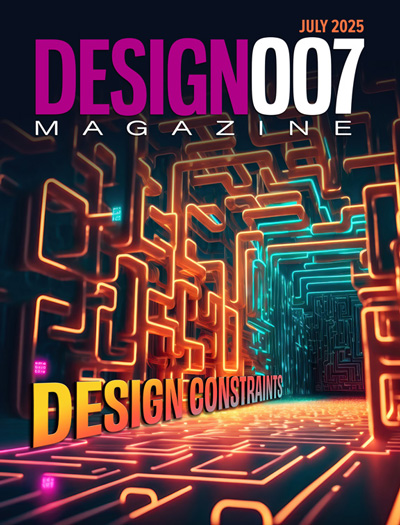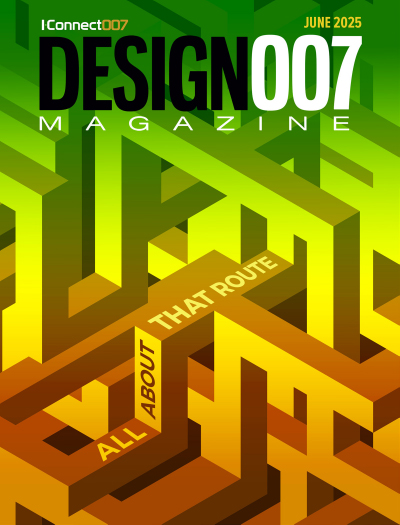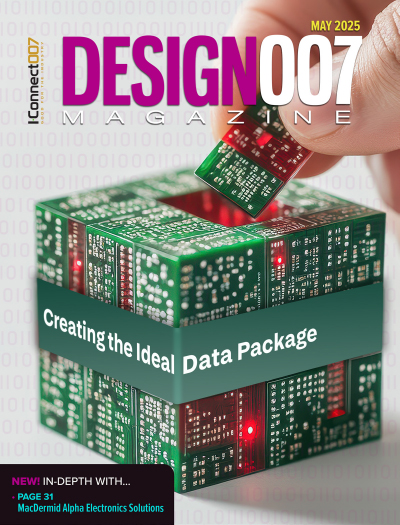-

- News
- Books
Featured Books
- design007 Magazine
Latest Issues
Current Issue
Showing Some Constraint
A strong design constraint strategy carefully balances a wide range of electrical and manufacturing trade-offs. This month, we explore the key requirements, common challenges, and best practices behind building an effective constraint strategy.

All About That Route
Most designers favor manual routing, but today's interactive autorouters may be changing designers' minds by allowing users more direct control. In this issue, our expert contributors discuss a variety of manual and autorouting strategies.

Creating the Ideal Data Package
Why is it so difficult to create the ideal data package? Many of these simple errors can be alleviated by paying attention to detail—and knowing what issues to look out for. So, this month, our experts weigh in on the best practices for creating the ideal design data package for your design.
- Articles
- Columns
- Links
- Media kit
||| MENU - design007 Magazine
Speeding up the Design Cycle: 10 Things to Remember
November 11, 2015 | Mark Thompson, CID, Prototron CircuitsEstimated reading time: 2 minutes
Many people understand the value of a PCB, but do not understand the best way to interact with PCB manufacturers. Poor planning and communication with fabricators slows down the design cycle and increases overall costs for your project.
In this column, I will attempt to help streamline the design cycle through fabrication. Following my tips will minimize the need for future revisions and ensure you get quality boards on time.
10. Eliminate Conflicting Information
It is essential that you eliminate any conflicting information from your drawings or read-me files. Make sure that all documentation is the same. If one document says half-ounce and another says one-ounce copper, you may expect a call asking which it is to be. If you need the part expedited, remember that this takes valuable time away from the build and from you getting your part.
9. Provide an IPC Netlist
An IPC netlist will allow the fabricator to check your design against your exported data. Make sure any known or intentional netlist mismatches are noted again so your CAM group does not waste time calling you to check on things you are already aware of.
Be careful with castellated pads where plated half-holes at the board’s edge will make a connection to a post at some point after fabrication. These typically come up as “broken” or open nets because when the bare boards are fabricated, no post exists to connect these castellations.
Known A-gnd to D-gnd shorts should also be noted. Make sure no non-plated holes have been specified as test points on the IPC netlist. If you are specifying net-compare on your documentation, be sure to include it!
8. Check for Discrepancies on NC Drill File
Double-check to ensure there are no discrepancies of count, size or plating status on the NC drill file. Either one of these can cause communication delays.
7. Communicate With Your Fabricator ASAP
In order to facilitate the best communication, you need to meet with your chosen fabricator as soon as possible in the design cycle. Check with them for validation of any impedance you may have. Make sure these notes do not conflict either.
Be sure to: Check for proper reference planes. Make sure impedance traces do not traverse multiple splits or lack ref-planes altogether. Differentiate between single-ended and differential type structures by a tenth or a hundredth of a mil. Again, fabricators cannot resolve these small increments, but this allows the fabricator to uniquely select just the impedance tracks for any resizing that may be necessary to meet desired impedances.
Make sure the space between differential pairs is consistent throughout the run. Allow for process deviation, setting up a part as .1 mm trace and space on half-ounce starting copper does not leave room for any trace resizing that may be necessary to meet the impedances if dielectric cannot be altered.
When calling out materials, call out the 4101/# such as 4101/126. This will allow the fabricator to use any material that falls within the /126 criteria. Calling out a specific material may limit the pool of fabricators that can build the board. Avoid creating same net spacing violations when terminating differential pairs, and do not “wrap” the differential pairs around the terminus.
To read this entire column, which appeared in the October 2015 issue of The PCB Design Magazine, click here.
Testimonial
"We’re proud to call I-Connect007 a trusted partner. Their innovative approach and industry insight made our podcast collaboration a success by connecting us with the right audience and delivering real results."
Julia McCaffrey - NCAB GroupSuggested Items
Statement from the Global Electronics Association on the July 2025 Tariff on Copper Foil and Electronics-Grade Copper Inputs
07/31/2025 | Global Electronics AssociationWe are disappointed by today’s decision to impose a 50% tariff on imported copper foil and other essential materials critical to electronics manufacturing in the United States.
Considering the Future of Impending Copper Tariffs
07/30/2025 | I-Connect007 Editorial TeamThe Global Electronics Association is alerting industry members that a potential 50% tariff on copper could hit U.S. electronics manufacturers where it hurts.
Connect the Dots: Sequential Lamination in HDI PCB Manufacturing
07/31/2025 | Matt Stevenson -- Column: Connect the DotsAs HDI technology becomes mainstream in high-speed and miniaturized electronics, understanding the PCB manufacturing process can help PCB design engineers create successful, cost-effective designs using advanced technologies. Designs that incorporate blind and buried vias, boards with space constraints, sensitive signal integrity requirements, or internal heat dissipation concerns are often candidates for HDI technology and usually require sequential lamination to satisfy the requirements.
OKI Launches Rigid-Flex PCBs with Embedded Copper Coins Featuring Improved Heat Dissipation for Space Equipment Applications
07/29/2025 | BUSINESS WIREOKI Circuit Technology, the OKI Group’s printed circuit board (PCB) business company, has developed rigid-flex PCBs with embedded copper coins that offer improved heat dissipation for use in rockets and satellite-mounted equipment operating in vacuum environments.
Designers Notebook: Basic PCB Planning Criteria—Establishing Design Constraints
07/22/2025 | Vern Solberg -- Column: Designer's NotebookPrinted circuit board development flows more smoothly when all critical issues are predefined and understood from the start. As a basic planning strategy, the designer must first consider the product performance criteria, then determine the specific industry standards or specifications that the product must meet. Planning also includes a review of all significant issues that may affect the product’s manufacture, performance, reliability, overall quality, and safety.


